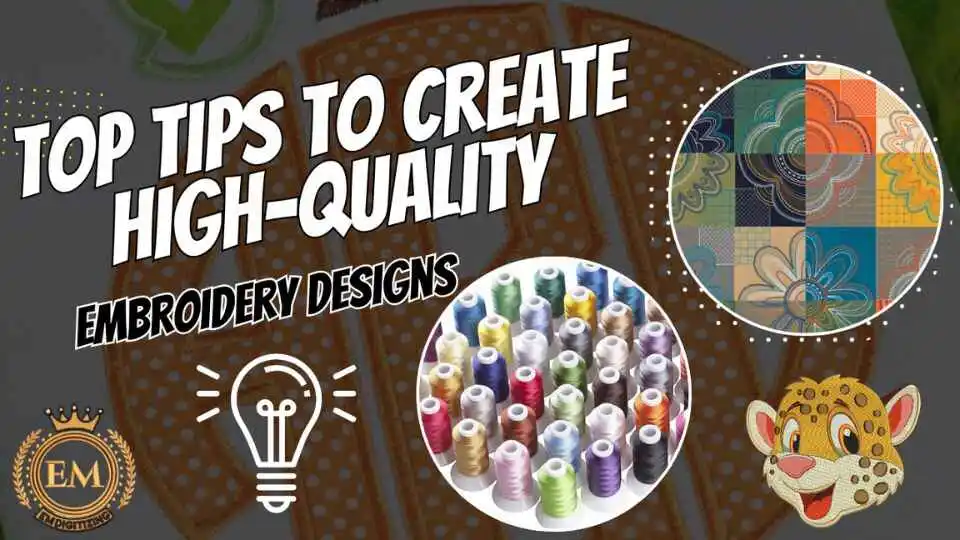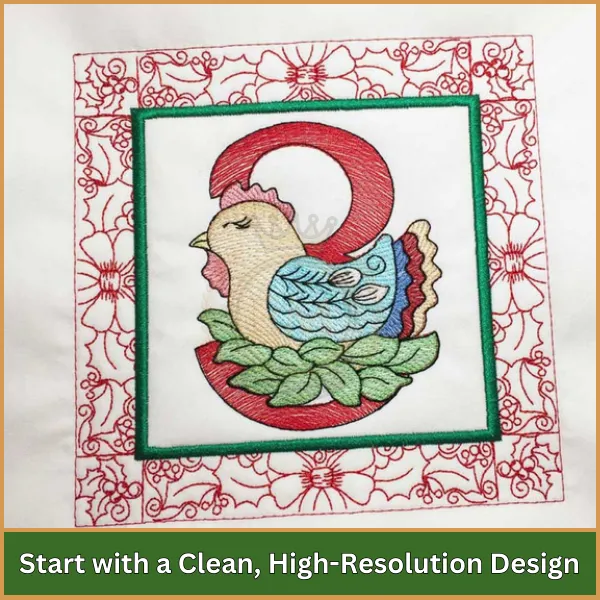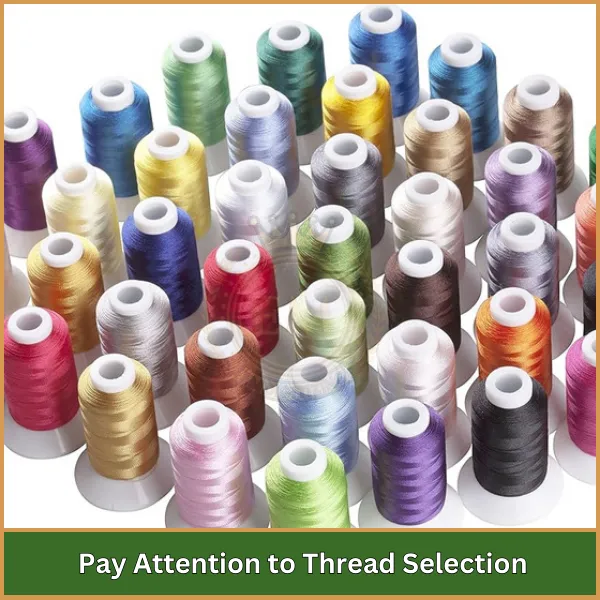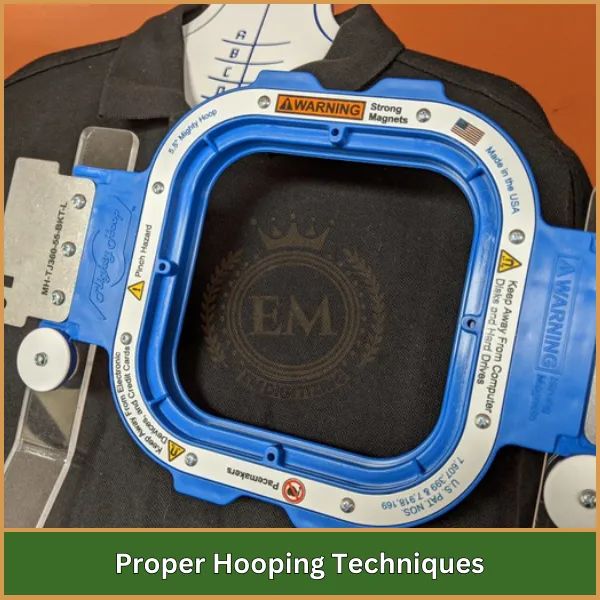Création motifs de broderie de haute qualité est tout sur les bonnes techniques et l'attention aux détails. En choisissant les meilleurs matériaux, en utilisant des astuces simples, et planifier soigneusement votre conception, Vous pouvez obtenir des résultats professionnels qui se démarquent.

Avec un peu de pratique et les bons conseils, Même des designs complexes peuvent être soignés et beaux. Chaque étape compte, de la sélection des couleurs à perfectionner vos points.
Explorons 17 Conseils de broderie professionnels pour vous aider à élaborer un design de broderie étonnant:
- Choisissez le bon logiciel de broderie
- Utilisez les formats de fichiers corrects
- Commencez par un propre, Conception haute résolution
- Sélectionnez le bon tissu pour votre conception
- Faites attention à la sélection des fils
- Optimisez votre conception pour les coutures
- Techniques de cerceau appropriées
- Testez votre conception avec un échantillon
- Maintenir et calibrer votre Machine à broder
- Collaborer avec un service de numérisation professionnelle
Conseils supérieurs pour créer des conceptions de broderie de haute qualité
1. Choisissez le bon logiciel de broderie
La droite logiciel de broderie est essentiel pour créer des conceptions de qualité professionnelle. Le logiciel avancé propose des outils comme la simulation de point, redimensionner, et édition, qui vous aident à personnaliser vos créations à la perfection.
Des programmes comme Wilcom, Éclore, et Brother PE-Design sont populaires pour leur facilité d'utilisation et leurs fonctionnalités puissantes. Recherchez un logiciel de conception de broderie qui prend en charge plusieurs formats de fichiers et fournit des tutoriels pour aider les débutants à démarrer. Investir dans des logiciels de haute qualité garantit un meilleur contrôle sur vos conceptions et minimise les erreurs lors de la couture.
2. Utilisez les formats de fichiers corrects
L'utilisation du format de fichier correct est essentiel pour la création motifs de broderie de haute qualité. Les machines à broder fonctionnent avec des formats spécifiques, comme l'heure d'été, PSE, JEF, et EXP, DST étant l'un des plus populaires.
Always check your machine’;S Compatibilité avant de sauver votre conception. De nombreux logiciels de broderie offrent une conversion facile entre les formats, vous permettant d'adapter vos conceptions pour différentes machines. Le formatage des fichiers approprié garantit en douceur sur vos points de conception et comme prévu, Éviter les erreurs ou les pépins.
3. Commencez par un propre, Conception haute résolution

La clarté de votre conception de broderie dépend fortement de la qualité de l'image d'origine.
Commencez toujours par une image haute résolution, car des images de faible qualité peuvent entraîner une broderie déformée ou pixélienne.
Simplifiez la conception en supprimant les détails inutiles qui peuvent ne pas se traduire bien dans les points.
Concentrez-vous sur les lignes épurées et les formes audacieuses pour les meilleurs résultats. Ajustez la taille de la conception pour s'adapter à votre tissu tout en maintenant sa clarté, Comme des conceptions trop complexes peuvent perdre leur attrait.
4. Sélectionnez le bon tissu pour votre conception
La sélection des tissus est cruciale pour atteindre motifs de broderie de haute qualité. Chaque type de tissu interagit différemment avec les points, so it’;s important pour faire correspondre votre conception avec le bon matériau. Tissus robustes comme le coton, toile, ou le denim sont excellents pour les conceptions détaillées, comme ils tiennent fermement les points sans distorsion.
Tissus extensibles comme Jersey, toutefois, exiger des stabilisateurs pour empêcher le plis et maintenir la clarté de conception. Évitez d'utiliser des tissus trop délicats ou excessivement épais, car ils peuvent être difficiles pour votre machine à gérer efficacement.
5. Faites attention à la sélection des fils

Le type et la qualité du fil que vous utilisez peuvent affecter considérablement le résultat de votre broderie.
Les fils de polyester sont durables et en couleur, Les rendre idéaux pour la plupart des projets. Fil de rayons, connu pour leur éclat, sont parfaits pour les dessins décoratifs.
Assurez-vous que la couleur du fil complète votre conception et votre tissu. Les fils de haute qualité réduisent les chances de rupture et de l'effilochage pendant les coutures, résultant en une broderie plus lisse.
En outre, Faites toujours correspondre le poids du fil aux exigences de votre projet et testez un échantillon de tissu pour assurer les meilleurs résultats.
Une sélection de threads appropriée améliore l'apparence globale et la durabilité de vos conceptions.
6. Optimisez votre conception pour les coutures
L'optimisation correcte de votre conception garantit qu'elle se coupe parfaitement. Cela comprend l'ajustement de la densité de point, paramètres de sous-couche, et réduire les chevauchements excessifs. Trop de points dans une petite zone peuvent provoquer un pli, Alors que trop peu peuvent laisser des lacunes.
La couture sous-couche fournit une base stable, Assurer la conception propre et professionnelle. Testez votre conception sur un tissu similaire pour vous assurer que tous les éléments sont alignés et optimisés.
7. Techniques de cerceau appropriées

Sécurisé et même cerceau est vital pour obtenir des conceptions de broderie de haute qualité.
Assurez-vous que le tissu est étroitement cerclé sans aucune ride, Comme le tissu lâche peut entraîner un désalignement ou un pli.
L'utilisation des bons stabilisateurs pour votre tissu ajoute le support nécessaire pour maintenir la précision.
Pour les matériaux délicats, Des cerceaux ou des clips magnétiques peuvent être une excellente solution, Garder le tissu stable et assurer la conception reste cohérent tout au long du processus de couture.
Vérifiez toujours la tension du cerceau avant de commencer à éviter de se déplacer pendant les coutures et d'assurer un, finition professionnelle.
8. Testez votre conception avec un échantillon
Exécuter un point de test sur un tissu similaire est une étape critique pour vous assurer que votre conception fonctionne comme prévu. Un échantillon vous aide à identifier les problèmes potentiels tels que les problèmes de tension du thread, désalignement, ou problèmes de densité de couture. Les tests vous permet de faire les ajustements nécessaires avant de travailler sur le tissu final, vous faire gagner du temps et prévenir les matériaux gaspillés.
9. Maintenir et calibrer votre machine à broder
Un bon entretien est l'un des conseils de broderie les plus cruciaux pour assurer un fonctionnement en douceur et des coutures de haute qualité. Nettoyer régulièrement la zone de la canette, Retirer la charpie, et huiler la machine selon les instructions du fabricant.
Assurez-vous que la tension du fil est correcte, et utilisez toujours une aiguille pointue qui correspond à votre type de tissu. Étalonnage, comme l'alignement de l'aiguille et du cerceau, Aide à maintenir la précision et à éviter les erreurs pendant le processus de broderie. Prendre soin de votre machine garantit cohérent, résultats professionnels à chaque fois.
10. Collaborer avec un service de numérisation professionnelle
La gestion des conceptions de broderies personnalisées complexes ou complexes peut être difficile, Mais un service de numérisation professionnelle comme EMnumérisation peut simplifier le processus. Ils se spécialisent dans la conversion des conceptions en formats compatibles à la machine avec des configurations de point précises.
Avec une expertise en densité de couture, sous-tendus, et optimisation de conception, Emdigitising garantit que vos projets de broderie obtiennent des résultats impeccables. S'appuyer sur un service professionnel permet non seulement de gagner du temps, mais garantit également des résultats de haute qualité, en particulier pour les projets détaillés ou en vrac.
Conclusion
La création de conceptions de broderie de haute qualité n'a pas besoin d'être difficile. Avec les bons conseils et techniques de conception de broderie, Vous pouvez faire des conceptions qui ont l'air soignées, professionnel, et se démarquer.
Chez EMDigitizing, Nous sommes ici pour soutenir votre voyage de broderie. Nous fournissons des services de numérisation professionnels aux prix les plus abordables, avec des délais d'exécution ultra-rapides et une qualité garantie.
Plus, Si vous nous essayez pour la première fois, vous obtiendrez une exclusivité 50% désactivé votre première commande. Ne manquez pas Cliquez ici Pour commencer et donner vie à vos conceptions de broderie!
FAQ
Le bon tissu dépend de votre conception et de votre type de projet. Les tissus stables comme le coton ou le denim sont parfaits pour les conceptions détaillées, tandis que les tissus extensibles peuvent nécessiter des stabilisateurs pour prévenir la distorsion.
La numérisation garantit que votre conception est prête pour la broderie machine en la convertissant en instructions de point précises. Cette étape est cruciale pour maintenir la précision et obtenir un résultat poli.
Tous les tissus ne conviennent pas à la broderie détaillée. Les tissus épais et robustes gèrent mieux les conceptions complexes, tandis que les tissus minces ou délicats peuvent avoir du mal avec de beaux détails.
Logiciel de broderie comme Wilcom, Éclat, ou Hatch est idéal pour créer et personnaliser des conceptions. Ces outils offrent des fonctionnalités avancées pour améliorer vos modèles et améliorer la qualité du point.
